sessionInfo()
R version 3.2.0 (2015-04-16)
Platform: x86_64-w64-mingw32/x64 (64-bit)
Running under: Windows 7 x64 (build 7601) Service Pack 1
locale:
[1] LC_COLLATE=German_Germany.1252 LC_CTYPE=German_Germany.1252
[3] LC_MONETARY=German_Germany.1252 LC_NUMERIC=C
[5] LC_TIME=German_Germany.1252
attached base packages:
[1] grid stats graphics grDevices utils datasets methods
[8] base
other attached packages:
[1] WriteXLS_3.5.1 tidyr_0.2.0 scales_0.2.4 gridExtra_0.9.1
[5] ggplot2_1.0.1 RPostgreSQL_0.4 DBI_0.3.1
loaded via a namespace (and not attached):
[1] Rcpp_0.11.6 assertthat_0.1 dplyr_0.4.1 digest_0.6.8
[5] MASS_7.3-40 plyr_1.8.2 gtable_0.1.2 magrittr_1.5
[9] stringi_0.4-1 lazyeval_0.1.10 reshape2_1.4.1 proto_0.3-10
[13] tools_3.2.0 stringr_1.0.0 munsell_0.4.2 parallel_3.2.0
[17] colorspace_1.2-6
#
library(RPostgreSQL)
library(ggplot2)
library(gridExtra)
library(scales)
library(tidyr)
blue.bold.italic.16.text <- element_text(face = "bold", color = "black", size = 12)
#
Consider four machines running in parllel and producing products. And the each dataframe(l1,l2,l3,l4) below represents no of pieces per hour for each machine (actually I collect data from database using RPostgreSQL and these is sample how it looks)
l1 <- structure(list(hours = structure(c(1434081600, 1434085200, 1434088800,
1434092400, 1434096000, 1434099600, 1434103200, 1434106800, 1434110400,
1434114000, 1434117600, 1434121200, 1434124800, 1434128400, 1434132000,
1434135600, 1434139200, 1434142800, 1434146400, 1434150000, 1434153600,
1434157200, 1434160800, 1434164400), class = c("POSIXct", "POSIXt"
), tzone = ""), count = c(25, 29, 28, 32, 33, 13, 33, 29, 32,
33, 27, 34, 25, 30, 13, 24, 26, 33, 40, 34, 26, 30, 22, 30)), .Names = c("hours",
"count"), row.names = c(NA, 24L), class = "data.frame")
l2 <- structure(list(hours = structure(c(1434081600, 1434085200, 1434088800,
1434092400, 1434096000, 1434099600, 1434103200, 1434106800, 1434110400,
1434114000, 1434117600, 1434121200, 1434124800, 1434128400, 1434132000,
1434135600, 1434139200, 1434142800, 1434146400, 1434150000, 1434153600,
1434157200, 1434160800, 1434164400), class = c("POSIXct", "POSIXt"
), tzone = ""), count = c(25, 29, 28, 32, 33, 13, 33, 29, 32,
33, 27, 34, 25, 30, 13, 24, 26, 33, 40, 34, 26, 30, 22, 30)), .Names = c("hours",
"count"), row.names = c(NA, 24L), class = "data.frame")
l3 <- structure(list(hours = structure(c(1434081600, 1434085200, 1434088800,
1434092400, 1434096000, 1434099600, 1434103200, 1434106800, 1434110400,
1434114000, 1434117600, 1434121200, 1434124800, 1434128400, 1434132000,
1434135600, 1434139200, 1434142800, 1434146400, 1434150000, 1434153600,
1434157200, 1434160800, 1434164400), class = c("POSIXct", "POSIXt"
), tzone = ""), count = c(25, 29, 28, 32, 33, 13, 33, 29, 32,
33, 27, 34, 25, 30, 13, 24, 26, 33, 40, 34, 26, 30, 22, 30)), .Names = c("hours",
"count"), row.names = c(NA, 24L), class = "data.frame")
l4 <- structure(list(hours = structure(c(1434081600, 1434085200, 1434088800,
1434092400, 1434096000, 1434099600, 1434103200, 1434106800, 1434110400,
1434114000, 1434117600, 1434121200, 1434124800, 1434128400, 1434132000,
1434135600, 1434139200, 1434142800, 1434146400, 1434150000, 1434153600,
1434157200, 1434160800, 1434164400), class = c("POSIXct", "POSIXt"
), tzone = ""), count = c(25, 29, 28, 32, 33, 13, 33, 29, 32,
33, 27, 34, 25, 30, 13, 24, 26, 33, 40, 34, 26, 30, 22, 30)), .Names = c("hours",
"count"), row.names = c(NA, 24L), class = "data.frame")
# here is my script for the attached plot(output)
df <- merge(l1,l2, by="hours")
df <- merge(df,l3, by="hours")
df <- merge(df,l4, by="hours")
colnames(df) <- c("hours","L 1","L 2","L 3","L 4")
pd <- gather(df, 'Ls', 'count', 2:5)
q <- ggplot(pd, aes(x = hours, y = count)) + geom_bar(stat = "identity") + theme(legend.position = "none")+
xlab("Time") + ylab("No.Of Pecies") +
ggtitle("my sample")+
scale_y_continuous(breaks=seq(0,45, by = 5))+
theme(axis.text = blue.bold.italic.16.text) +
scale_x_datetime(breaks=date_breaks("2 hour"),minor_breaks=date_breaks("2 hour"),labels=date_format("%H")) +
theme(axis.text.x=element_text(angle=0))+
facet_grid(~ Ls)

# when all the 4 machines are working - everything is fine, i will run the above script and i will get the rquired output.
Incase if any machine is not working and i have a dataframe with empty rows..then i will get an error while running my script file.
@ df <- merge(l1,l2, by="hours")
df <- merge(df,l3, by="hours")
df <- merge(df,l4, by="hours")
Error in fix.by(by.y, y) : 'by' must specify a uniquely valid column
and the next error at
pd <- gather(df, 'Ls', 'count', 2:5)
how to avoid the empty dataframes and run the script succesfully to produce the output with whatever the no of machines are operating (either it is 2 or 3 or 4)
